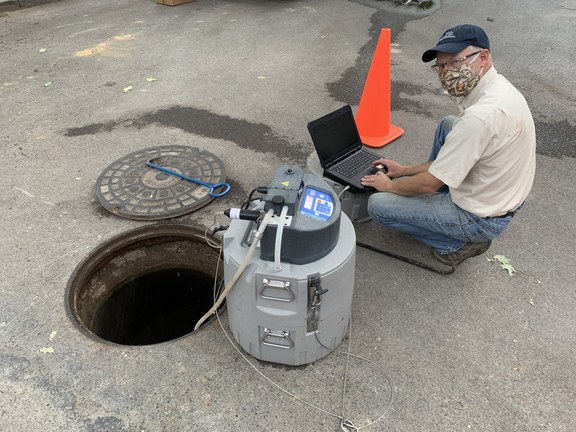Using surveillance tactics to alert and prevent virus spread.
Problem
How can communities better anticipate and mitigate the spread of COVID-19?
Findings
Research has shown that fragments of the RNA from SARS-CoV-2 is present in human waste. As a result, sampling wastewater for the virus has the potential to give an overall snapshot of its prevalence in a community.
- The team monitored existing flow meters in several manholes at the University Park campus to determine the volume of water passing through and used devices programmed to collect water samples every 5 minutes for 24 hours in the manholes as well as from the treatment plants on campus and in the surrounding community.
- A technique called polymerase chain reaction (PCR) amplified the genetic material in the samples to the level of detection and recorded the concentration of virus fragments per milliliter of water to track the rate of increase or decrease in the concentration over time.
Impact
Wastewater monitoring provides a cost-effective way of monitoring for things that are rare; for example, polio is monitored in this way throughout the world.
- Adding this surveillance tool helps to enhance monitoring for COVID-19 and could enable leaders to take swift actions to minimize the virus's spread to help protect the health and safety of the community.
Research Credit
Team
- Heather Preisendanz, Andrew Read, Tom Richard, Shirley Clark, Matt Jones, Justin Silverman, Michael Shreve, David Swisher, Cory Miller, Kathryn Hayden, Olivia Mroczko
Participating Departments
Partners
- Penn State Huck Institutes of the Life Sciences
- Penn State Office of the Physical Plant
- University Area Joint Authority
- Penn State College of Information Sciences and Technology
- USDA Agricultural Research Service Pasture Systems &
- Watershed Management Research Unit
- Penn State Institutes of Energy and the Environment
- Pennsylvania Department of Health
Other Funding
- Penn State Office of the Provost
- Penn State College of Agricultural Sciences Institute for Sustainable Agricultural, Food, and Environmental Sciences (SAFES)
- Penn State Huck Institutes of the Life Sciences
Federal and State Appropriations
Emerging Discoveries
Office for Research and Graduate Education
Address
217 Agricultural Administration BuildingUniversity Park, PA 16802-2600
- Email agresearch@psu.edu
- Office 814-865-3136
Office for Research and Graduate Education
Address
217 Agricultural Administration BuildingUniversity Park, PA 16802-2600
- Email agresearch@psu.edu
- Office 814-865-3136



